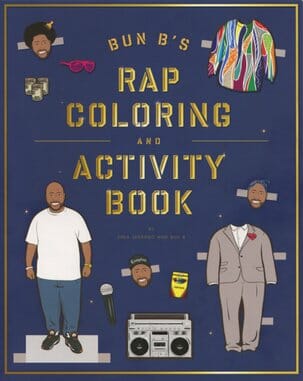Bun B’s Rap Coloring And Activity Book by Shea Serrano and Bun B
Out Here On The Grind, Keepin’ Money On Our Mind

Are you worried your 6-year-old doesn’t appreciate the 2pac albums you bump every Saturday morning?
What do you do when your child shows no interest in Big Daddy Kane, yawns during Jay-Z’s Reasonable Doubt and plugs his ears to avoid your discussion of New York rappers?
If these problems sound familiar, there may a new item to ease your troubles. Bun B’s Rap Coloring And Activity Book, a collaboration between the rapper Bun B and the writer/illustrator Shea Serrano, shows kids who’s who in the hip-hop world, or, at the very least, keeps them coloring.
Or not. The book is intended “for adults,” Serrano told the site allhiphop.com. “Kids shouldn’t listen to rap music and definitely shouldn’t listen to the rappers that we [include]…If it lands in a kid’s lap, then cool; he’s going to like it…but we’re kind of making this for rap fans.” To the Village Voice: “It’s not built for kids—it’s more for music fans.”
So kids— stay in school! And don’t buy this!
Bun B’s Rap Coloring and Activity Book contains illustrations of some 40 rappers, hailing from East, West, North and South. A few came up back in the ‘80s, but most started in the ‘90s and ‘00s. A couple of female MCs make the cut, but, as in hip hop itself, we find largely male faces staring back from the book’s pages.
Who is Bun B? Certainly not the rapper awarded “most likely to have his name on a coloring book.” As one half of the duo UGK, Bun B helped establish southern rap, first as an art-form, and eventually as a commercial force when the southern rappers a few years behind Bun knocked down the door he inched open, sweeping the genre to national prominence.
In the UGK albums, the first of which came out in the early ‘90s, you can find Bun B’s low, booming raps, usually dark, matter-of-fact narratives about poor neighborhoods, drug deals, murders and prostitution. Bun’s bars come paired with lush beats, filled with ‘70s-sounding funk guitar and rhythms that stretch and unfurl, comfortable in their power and appeal. The other member of UGK, Pimp C, died in December of 2007. Bun soldiers on. A survivor. A professional.
He also doesn’t play much of a role in the book—according to Serrano, he mainly “lend[s] his street cred and occasionally his face.” Serrano, responsible for the pictures and words, has written and drawn for a number of publications and seems to be an all-around witty guy. He invents funny fake Twitter conversations, for example, with Kobe Bryant and Dwight Howard for Grantland. He reworks scenes from the show Breaking Bad to include the rapper Drake.
Serrano draws in black and white, so artistic readers of the Rap Activity And Coloring Book may feel free to bring to life whatever looks they favor on this collection of MCs. Hoping to see Drake wearing tie-dye? Make your dreams come true. The rappers come with accessories—hats, tats, watches, $100 bills, suits and boom boxes—all of which can be colored to your specifications.
For even more fun, the book includes games based on rap-fan in-jokes. The drawing of Bay-Area rapper E-40, famous for inventing new slang, comes with a word search (hidden words include “Fo’ Sheezy,” “Po-po,” and “Scrilla.”)
-

-

-

-

-

-

-

-

-

-

-

-

-

-

-

-

-

-

-

-

-

-

-

-

-

-

-

-

-

-

-

-

-

-

-

-

-

-

-

-








































